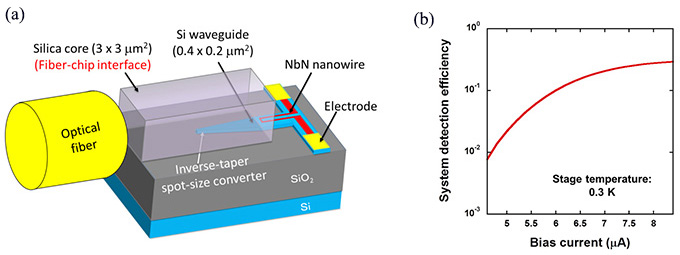Superconducting Nanowire Single Photon Detector on Si Platform
Quantum photonics technology has attracted attentions for quantum computing and quantum-code communications. In particular, a silicon (Si) photonics technology is widely studied for the scalable quantum photonics system. One of key challenges for the Si photonics is to integrate a single-photon detector, because traditional Si avalanche photodiodes cannot detect infrared photons. The promising solution is a waveguide-integrated superconducting nanowire single-photon detector (SNSPD) [1] on Si platform, because it can detect infrared photons with low noise and small jitter. However, the system detection efficiency of the SNSPD is still limited by a large fiber coupling loss [2]. In this work, we demonstrated a high-system-detection SNSPD integrated with Si nanowire waveguide and spot-size converter (SSC), which efficiently couples to the fiber.
Figure 1(a) shows a schematic of waveguide-integrated SNSPD with SSC. The superconducting nanowire was comprised of niobium nitride (NbN) whose thickness and width were 7 nm and 60 nm, respectively. The NbN nanowire was evanescently coupled to the Si nanowire waveguide. The Si waveguide has inverse taper structure, which is covered with a 3-μm-square SiOx waveguide to construct SSC [3]. The mode-field diameter of the SiOx core nearly matched that of the high-numerical aperture fiber. The key fabrication process is the low-temperature formation of the SiOx waveguide (< 200°C), which prevents thermal damage to the NbN film.
We measured the system detection efficiency of the fabricated SNSPD in a cryostat. In the experiment, input continuous-wave light power was attenuated to have 106 photons per second outside the cryostat. The cryostat state was at 0.3 K. Figure 1(b) shows measured relationship between system detection efficiency and bias current. The system detection efficiency was around 32%, which is over ten times larger than that of the previous devices. The fiber-chip coupling loss was remarkably small (1.9 dB/facet). It is notable that the on-chip detection efficiency of the SNSPD was over 90%. It means the low-temperature integration process successfully prevent thermal damages to NbN nanowires. These results indicated the Si-NbN-SiOx integration technology is a promising solution for constructing future quantum photonics systems.
- [1] J. P. Sprengers et al., Appl. Phys. Lett. 99, 181110 (2011).
- [2] O. Kahl et al., Sci. Rep. 5, 10941 (2015).
- [3] T. Hiraki et. al., Proc. in Frontiers in Optics, FW5F.3 (2016).

|
Fig. 1. (a) Schematic of SNSPD with SSC. (b) measured system detection efficiency. |